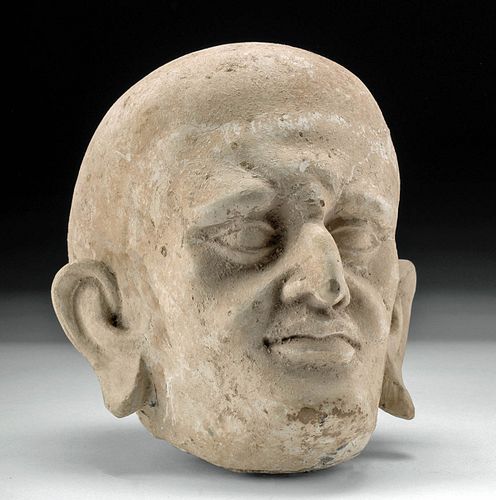Gandharan Stucco Head of an Elderly Man
Lot 59a
About Seller
Artemis Fine Arts
686 S Taylor Ave, Ste 106
Louisville, CO 80027
United States
Selling antiquities, ancient and ethnographic art online since 1993, Artemis Gallery specializes in Classical Antiquities (Egyptian, Greek, Roman, Near Eastern), Asian, Pre-Columbian, African / Tribal / Oceanographic art. Our extensive inventory includes pottery, stone, metal, wood, glass and textil...Read more
Estimate:
$1,500 - $2,000
Absentee vs Live bid
Two ways to bid:
- Leave a max absentee bid and the platform will bid on your behalf up to your maximum bid during the live auction.
- Bid live during the auction and your bids will be submitted real-time to the auctioneer.
Bid Increments
| Price | Bid Increment |
|---|---|
| $0 | $25 |
| $300 | $50 |
| $1,000 | $100 |
| $2,000 | $250 |
| $5,000 | $500 |
| $10,000 | $1,000 |
| $20,000 | $2,500 |
| $50,000 | $5,000 |
| $100,000 | $10,000 |
| $200,000 | $20,000 |
About Auction
By Artemis Fine Arts
Jan 21, 2021
Set Reminder
2021-01-21 10:00:00
2021-01-21 10:00:00
America/New_York
Bidsquare
Bidsquare : Ancient / Ethnographic From Around The World
https://www.bidsquare.com/auctions/artemis-gallery/ancient-ethnographic-from-around-the-world-6316
Ancient art from Egypt, Greece, Italy and the Near East, as well as Asian, Pre-Columbian, Native American, African / Tribal / Oceanic, Spanish Colonial, Russian Icons, Fine art, much more! All categories, all price ranges... all legally acquired and guaranteed to be as described or your money back. Artemis Fine Arts info@artemisgallery.com
Ancient art from Egypt, Greece, Italy and the Near East, as well as Asian, Pre-Columbian, Native American, African / Tribal / Oceanic, Spanish Colonial, Russian Icons, Fine art, much more! All categories, all price ranges... all legally acquired and guaranteed to be as described or your money back. Artemis Fine Arts info@artemisgallery.com
- Lot Description
Ancient Central Asia, Pakistan, India, and Afghanistan, Gandharan Empire, ca. late 2nd to 4th century CE. An incredibly naturalistic head of an elderly man sculpted by hand from white stucco that has assumed an aged, pale beige hue. The bulbous head exhibits a keen sense of verism created by his thin lidded, almond-shaped eyes, an aquiline nose with delineated nostrils, recessed cheek bones and deep nasolabial folds, full lips with a grooved philtrum, and a prominent chin. Both ears are of a cupped form with elongated lobes that flare slightly outwards from the back of his mandible, and his bald head has a rounded, hemispherical shape. The chipped nature of the verso and neckline suggests that this head was at one time part of a larger figure connected to a tall frieze. An incredible example of early Gandharan figurative artistry! Size: 6.2" W x 6.875" H (15.7 cm x 17.5 cm)
Gandharans are famous for schist and stucco carvings, with stucco replacing schist as the dominant material around the 3rd century CE. Vast monastic institutions like those at Takht-i-Bahi, Sahri-Bahlol, Jamal Garhi, Ranigat, and Thareli were decorated by skilled artisans with stucco representations of important figures, religious scenes, and artistic dedications. Stucco allowed artists more freedom in portraying lifelike features. During this time, Gandhara was exceptionally wealthy, profiting from trade along the Silk Road; patrons had resources to spend on the arts, creating a flowering of stucco artwork. Some monumental statues had stucco hands, feet, and heads alongside clay torsos - the size of these figures was such that clay was needed to maintain their form.
Provenance: private southern California, USA collection, acquired before 2000
All items legal to buy/sell under U.S. Statute covering cultural patrimony Code 2600, CHAPTER 14, and are guaranteed to be as described or your money back.
A Certificate of Authenticity will accompany all winning bids.
We ship worldwide and handle all shipping in-house for your convenience.
#159048This head is likely from a larger figure and frieze panel. Repaired from several large pieces, with restoration to areas surrounding both ears, tip of nose, and one area beneath chin, with resurfacing and overpainting along new material and break lines. Several stable fissures along top and verso, with extensive encrustations, chipping to neckline, peripheries, and verso, and light softening to some facial details. Great earthen deposits and nice preservation of stucco.Condition
- Shipping Info
-
All shipping is handled in-house for your convenience. Your invoice from Artemis Gallery will include shipping calculation instructions. If in doubt, please inquire BEFORE bidding for estimated shipping costs for individual items.
-
- Buyer's Premium



 EUR
EUR CAD
CAD AUD
AUD GBP
GBP MXN
MXN HKD
HKD CNY
CNY MYR
MYR SEK
SEK SGD
SGD CHF
CHF THB
THB














